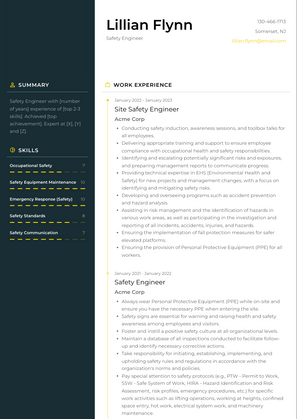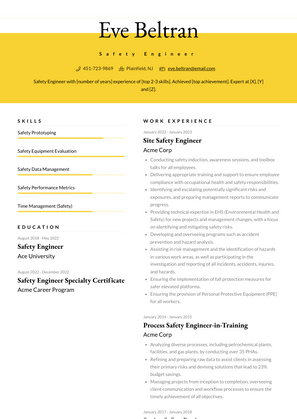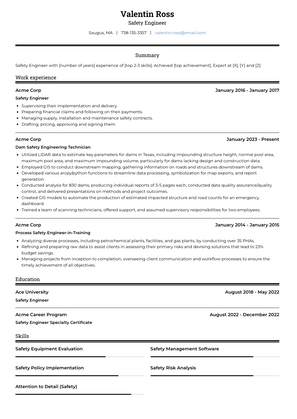Safety Engineer Resume Examples and Templates
This page provides you with Safety Engineer resume samples to use to create your own resume with our easy-to-use resume builder. Below you'll find our how-to section that will guide you through each section of a Safety Engineer resume.



What do Hiring Managers look for in a Safety Engineer Resume
- Safety Knowledge: Strong knowledge of safety regulations, standards, and best practices in the relevant industry.
- Risk Assessment: Ability to assess workplace hazards, identify risks, and develop safety strategies.
- Technical Proficiency: Proficiency in safety-related software, tools, and equipment.
- Communication Skills: Effective communication to convey safety protocols, train employees, and collaborate with teams.
- Problem-Solving Abilities: Capability to analyze safety issues, propose corrective actions, and ensure compliance with safety regulations.
How to Write a Safety Engineer Resume?
To write a professional Safety Engineer resume, follow these steps:
- Select the right Safety Engineer resume template.
- Write a professional summary at the top explaining your Safety Engineer’s experience and achievements.
- Follow the STAR method while writing your Safety Engineer resume’s work experience. Show what you were responsible for and what you achieved as a Safety Engineer.
- List your top Safety Engineer skills in a separate skills section.
Advance your engineering career with a professionally crafted resume. Our engineering resume writing service showcases your technical expertise, project achievements, and problem-solving skills to help you secure top engineering roles.
How to Write Your Safety Engineer Resume Header?
Write the perfect Safety Engineer resume header by:
- Adding your full name at the top of the header.
- Add a photo to your resume if you are applying for jobs outside of the US. For applying to jobs within the US, avoid adding photo to your resume header.
- Add your current Safety Engineering position to the header to show relevance.
- Add your current city, your phone number and a professional email address.
- Finally, add a link to your portfolio to the Safety Engineer resume header. If there’s no portfolio link to add, consider adding a link to your LinkedIn profile instead.
Bad Safety Engineer Resume Example - Header Section
Lillian 7600 W. Bay Meadows Avenue Rochester, NY 14606 Marital Status: Married, email: cooldude2022@gmail.com
Good Safety Engineer Resume Example - Header Section
Lillian Flynn, Rochester, NY, Phone number: +1-555-555-5555, Link: linkedin/in/johndoe
Make sure to add a professional looking email address while writing your resume header. Let’s assume your name is John Doe - here is a formula you can use to create email addresses:
- firstnamelastname@email.com - johndoe@email.com
- firstname.lastname@email.com - john.doe@email.com
- lastname.firstname@email.com - doe.john@email.com
- f.lastname@email.com - j.doe@email.com
- l.firstname@email.com - d.john@email.com
- firstnamelastname12@email.com - johndoe12@email.com
For a Safety Engineer email, we recommend you either go with a custom domain name (john@johndoe.com) or select a very reputed email provider (Gmail or Outlook).
How to Write a Professional Safety Engineer Resume Summary?
Use this template to write the best Safety Engineer resume summary: Safety Engineer with [number of years] experience of [top 2-3 skills]. Achieved [top achievement]. Expert at [X], [Y] and [Z].
How to Write a Safety Engineer Resume Experience Section?
Here’s how you can write a job winning Safety Engineer resume experience section:
- Write your Safety Engineer work experience in a reverse chronological order.
- Use bullets instead of paragraphs to explain your Safety Engineer work experience.
- While describing your work experience focus on highlighting what you did and the impact you made (you can use numbers to describe your success as a Safety Engineer).
- Use action verbs in your bullet points.
Dam Safety Engineering Technician Resume Example
Dam Safety Engineering Technician
- Utilized LiDAR data to estimate key parameters for dams in Texas, including impounding structure height, normal pool area, maximum pool area, and maximum impounding volume, particularly for dams lacking design and construction data.
- Employed GIS to conduct downstream mapping, gathering information on roads and structures downstream of dams.
- Developed various arcpy/python functions to streamline data processing, symbolization for map exports, and report generation.
- Conducted analysis for 830 dams, producing individual reports of 3-5 pages each, conducted data quality assurance/quality control, and delivered presentations on methods and project outcomes.
- Created GIS models to automate the production of estimated impacted structure and road counts for an emergency dashboard.
- Trained a team of scanning technicians, offered support, and assumed supervisory responsibilities for two employees.
Site Safety Engineer Resume Example
Site Safety Engineer
- Conducting safety induction, awareness sessions, and toolbox talks for all employees.
- Delivering appropriate training and support to ensure employee compliance with occupational health and safety responsibilities.
- Identifying and escalating potentially significant risks and exposures, and preparing management reports to communicate progress.
- Providing technical expertise in EHS (Environmental Health and Safety) for new projects and management changes, with a focus on identifying and mitigating safety risks.
- Developing and overseeing programs such as accident prevention and hazard analysis.
- Assisting in risk management and the identification of hazards in various work areas, as well as participating in the investigation and reporting of all incidents, accidents, injuries, and hazards.
- Ensuring the implementation of fall protection measures for safer elevated platforms.
- Ensuring the provision of Personal Protective Equipment (PPE) for all workers.
Safety Engineer Resume Example
Safety Engineer
- Always wear Personal Protective Equipment (PPE) while on-site and ensure you have the necessary PPE when entering the site.
- Safety signs are essential for warning and raising health and safety awareness among employees and visitors.
- Foster and instill a positive safety culture at all organizational levels.
- Maintain a database of all inspections conducted to facilitate follow-up and identify necessary corrective actions.
- Take responsibility for initiating, establishing, implementing, and upholding safety rules and regulations in accordance with the organization's norms and policies.
- Pay special attention to safety protocols (e.g., PTW - Permit to Work, SSW - Safe System of Work, HIRA - Hazard Identification and Risk Assessment, risk profiles, emergency procedures, etc.) for specific work activities such as lifting operations, working at heights, confined space entry, hot work, electrical system work, and machinery maintenance.
Fire Safety Engineer Resume Example
Fire Safety Engineer
- Specialized in CFD (Computational Fluid Dynamics), evacuation, and fire safety strategies for buildings and infrastructure.
- Proficient in both performance-based and code-based design approaches for projects.
- Took on the role of conducting thermo-mechanical analysis of structural members and components.
- Collaborated closely with fire, structural, and automation teams to develop integrated designs for projects.
- Actively participated in client and stakeholder meetings to facilitate project implementation.
SAFETY ENGINEER Resume Example
SAFETY ENGINEER
- Supervising project execution while adhering to safety protocols and maneuvers.
- Conducting daily safety observations and maintaining photographic reports, both before and after.
- Preparing and managing ISO 45001 health and safety documents for Saudi Electricity Company (SEC).
- Ensuring the calibration certificates of all Testing and Commissioning Equipment, including Megger Testing Machine, High Voltage Cable Testing Machine, and Cable Pulling Machine, are valid and authorized.
- Certifying and creating safety documents such as Work Permits, Risk Assessments, and Method Statements.
- Implementing the company's Health and Safety Plan on-site, regularly reviewing it for necessary changes, and preparing Emergency Exit Plans, as needed.
- Conducting internal safety site audits, including audits with Site Engineers, Consultants, and Clients to ensure compliance with safety protocols.
- Compiling bi-weekly progress reports and photographic documentation for the Consultant.
Safety Engineer Resume Example
Safety Engineer
- Ensuring road safety and promptly addressing traffic congestion to maintain smooth traffic flow.
- Auditing existing programs and procedures to verify compliance with Corporate Policies and Procedures.
- Conducting hazard and job safety analyses to promote proper utilization of machinery, equipment, personal protective gear, and procedures.
- Preparing comprehensive reports detailing findings and providing recommendations for necessary corrective actions.
- Identifying opportunities to enhance functional safety and environmental productivity through the use of personal computer technology.
Senior Safety Engineer Resume Example
Senior Safety Engineer
- Supporting and implementing effective Health & Safety Policies, guidelines, schedules (such as Safety Operating System, Safety Process Review Board, MTC, Safety committee meetings, Union Safety Meetings, Pedestrian Safety Committee Meetings, etc.), and procedures.
- Enforcing Safe Work Practices, including reviewing Method Statements and Risk Assessments, conducting Design Safety Reviews, ESR (Engineering Safety Reviews), Material Flow Studies, and obtaining layout approvals for each activity. Also, overseeing Safety Plans, Management Safety Walks, and specialized safety training.
- Leading in Behavioral Safety initiatives, serving as a leader for the Safety Observation Index, and encouraging the team to adopt a Safety Mindset and safe behaviors.
- Managing Emergency Management Systems, including safety sign-offs for new buildings in compliance with building codes, global standards, and Fire Bulletins, as well as organizing Mock Drills and Business Continuity Plans.
- Motivating employees by promoting the use of PPEs, facilitating Safety Committee meetings, celebrating Safety days/weeks, publishing Safety bulletins, and recognizing Safety achievements through awards to foster a culture of participative management and elevate safety standards.
- Ensuring Legal and Statutory Compliance by identifying all applicable statutes across the plant and maintaining a legal calendar to ensure 100% compliance.
Safety Engineer Resume Example
Safety Engineer
- Supervising their implementation and delivery.
- Preparing financial claims and following on their payments.
- Managing supply, installation and maintenance safety contracts.
- Drafting, pricing, approving and signing them.
Safety Engineer Resume Example
Safety Engineer
- Reviewing plans and specifications for new machinery and equipment to ensure compliance with safety requirements.
- Identifying and rectifying potential hazards through thorough inspections of facilities, machinery, and safety equipment.
- Assessing the efficacy of various industrial control mechanisms.
- Ensuring that buildings or products adhere to health and safety regulations.
- Installing safety devices on machinery or overseeing their installation.
- Evaluating employee safety programs and providing recommendations for enhancements.
- Staying current with knowledge of prevailing policies, regulations, and industrial processes.
Process Safety Engineer-in-Training Resume Example
Process Safety Engineer-in-Training
- Analyzing diverse processes, including petrochemical plants, facilities, and gas plants, by conducting over 35 PHAs.
- Refining and preparing raw data to assist clients in assessing their primary risks and devising solutions that lead to 23% budget savings.
- Managing projects from inception to completion, overseeing client communication and workflow processes to ensure the timely achievement of all objectives.
Top Safety Engineer Resume Skills for 2023
- Safety Engineering
- Risk Assessment (Safety)
- Safety Regulations
- Occupational Safety
- Hazard Analysis
- Safety Inspections
- Safety Standards
- Safety Compliance
- Safety Management Systems
- Safety Training
- Incident Investigation (Safety)
- Safety Audits
- Safety Policies
- Emergency Response (Safety)
- Workplace Safety
- Safety Protocols
- Safety Planning
- Safety Documentation
- Safety Reporting
- Safety Data Analysis
- Safety Prototyping
- Safety Testing
- Safety Equipment Evaluation
- Safety Procedures
- Safety Risk Mitigation
- Safety Incident Reporting
- Safety Communication
- Safety Program Development
- Safety Culture Promotion
- Safety Performance Metrics
- Safety Technology Integration
- Safety Regulations Compliance
- Safety Equipment Inspection
- Health and Safety (Safety)
- Environmental Health and Safety
- Safety Program Evaluation
- Safety Training Development
- Safety Consultation
- Safety Data Management
- Safety Policy Implementation
- Safety Risk Analysis
- Communication Skills (Safety)
- Problem Solving (Safety)
- Attention to Detail (Safety)
- Time Management (Safety)
- Team Collaboration (Safety)
- Safety Incident Investigation
- Safety Equipment Maintenance
- Safety Management Software
- Safety Program Documentation
How Long Should my Safety Engineer Resume be?
Your Safety Engineer resume length should be less than one or two pages maximum. Unless you have more than 25 years of experience, any resume that’s more than two pages would appear to be too long and risk getting rejected.
On an average, for Safety Engineer, we see most resumes have a length of 2. And, that’s why we advise you to keep the resume length appropriate to not get rejected.
What should I include in my objective statement on a safety engineer resume?
Your objective statement should highlight your experience in safety engineering, knowledge of safety regulations, and your commitment to ensuring a safe working environment. For example: "Dedicated Safety Engineer with [number] years of experience in identifying hazards, conducting risk assessments, and implementing safety protocols. Seeking to leverage my expertise in safety management, regulatory compliance, and accident prevention to support a culture of safety at [Company Name]."
How can I highlight relevant skills on a safety engineer resume if I have limited experience?
If you have limited experience, focus on your technical training, certifications, and any projects or internships where you worked with safety protocols or conducted risk assessments. Highlight your knowledge of safety regulations (such as OSHA or ISO standards), your ability to identify potential hazards, and your skills in conducting safety audits and inspections. Emphasize your problem-solving abilities, attention to detail, and your commitment to promoting a safe work environment.
Should I include volunteer work on my safety engineer resume?
Yes, including volunteer work is valuable, especially if it involved safety initiatives, emergency planning, or any projects related to health and safety. Volunteer experiences that demonstrate your ability to assess risks, develop safety plans, or educate others on safety practices can strengthen your resume and show your dedication to the field.
How can I demonstrate my expertise in safety engineering on my resume?
To demonstrate your expertise, include details about your experience with specific safety engineering tasks, such as conducting hazard analyses, developing safety protocols, and leading safety training sessions. Highlight your familiarity with safety regulations, your experience in accident investigation, and your ability to design and implement safety systems. Mention any relevant certifications, such as Certified Safety Professional (CSP), Certified Industrial Hygienist (CIH), or OSHA certification.
What should I include in the education section of my safety engineer resume?
Include your highest level of education, such as a Bachelor’s or Master’s degree in Safety Engineering, Environmental Health and Safety (EHS), or a related field. If you’ve completed any specialized courses or certifications in safety management, risk assessment, or industrial hygiene, be sure to include those as well. Mention any academic projects, labs, or coursework that provided you with practical experience in safety engineering.
Can I include non-engineering work experience on my safety engineer resume?
Yes, non-engineering work experience can be valuable, especially if it demonstrates skills such as risk management, project management, or regulatory compliance. For example, roles in construction, manufacturing, or any position that required you to ensure safety standards, conduct inspections, or manage safety procedures can provide relevant experience for a safety engineer position.
How do I format a safety engineer resume with limited experience?
Use a clean and professional format with sections for your objective, skills, education, and experience. Start with a strong objective statement that outlines your enthusiasm for the role. Then, list your relevant technical skills and any experience, including internships, volunteer work, or entry-level positions, that demonstrate your ability to handle the responsibilities of a safety engineer. Highlight any certifications or training that support your qualifications.
How important is a cover letter when applying for a safety engineer position with limited experience?
A cover letter is very important as it allows you to explain your passion for safety engineering and why you’re a great fit for the job, even with limited experience. Use the cover letter to highlight your technical skills, any relevant projects or coursework, and your commitment to ensuring a safe and compliant workplace. Tailoring your cover letter to the specific industry and the safety challenges they face can help make a strong impression.
How can I make my safety engineer resume stand out with limited experience?
To make your resume stand out, focus on your technical skills, certifications, and any hands-on experience you’ve gained through training, internships, or personal projects. Highlight your ability to assess risks, develop safety protocols, and ensure compliance with safety regulations. Tailoring your resume to the specific needs of the employer and the safety requirements of their industry can also help you differentiate yourself from other candidates.
-
What do Hiring Managers look for in a Safety Engineer Resume
-
What should I include in my objective statement on a safety engineer resume?
-
How can I highlight relevant skills on a safety engineer resume if I have limited experience?
-
Should I include volunteer work on my safety engineer resume?
-
How can I demonstrate my expertise in safety engineering on my resume?
-
What should I include in the education section of my safety engineer resume?
-
Can I include non-engineering work experience on my safety engineer resume?
-
How do I format a safety engineer resume with limited experience?
-
How can I make my safety engineer resume stand out with limited experience?
Copyright ©2025 Workstory Inc.
